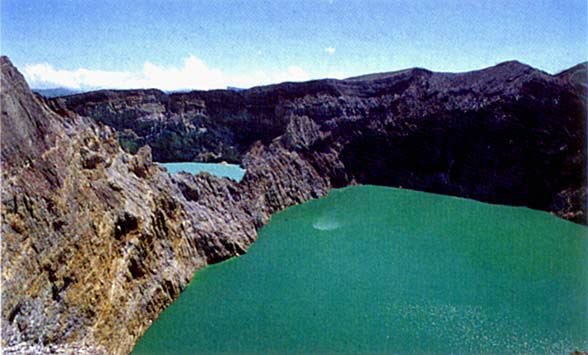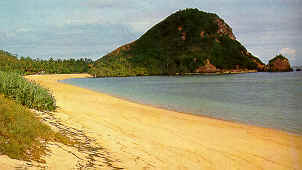
EAST NUSA TENGGARA
Kalimutu Three Colored Craters
Source: www.eastindonesia.com
Kupang is the capital city of East Nusa
Tenggara, the province which covers 111 islands. The main islands include
Timor, Roti, Sawu, Solor, Alor, Sumba, Ende, Flores, and Komodo.
The province is well known for its tenun ikat (handmade cloth or hand woven
textiles). This province has many distinguish cultures. It also has many beautiful
beaches. Prehistoric reptiles, the Komodo dragons, inhabit the Komodo Island. These
are the biggest lizards, weighing about 100 lbs. Komodo
dragons are carnivores (meat eaters) and will devour any animal they are capable of
dismembering and gulping down. Although they are for the most part scavengers, they do
capture live prey, including deer, pigs, birds, even young dragons. The young can escape
by climbing trees, because the much-heavier adults cannot climb. Komodo dragons are good
swimmers and have been reported hunting in the surf for fish and birds.
Kelimutu Volcano (also known as Geli
Mutu) is a 1640 meter high stratovolcano located at Ende Regency, Central Flores. On the summit area, three craters are found. These
craters have three different water colors, which are blue, greenish, and red. The water
color is changed from year to year due to the activity of the magma.
More about East Nusa Tenggara
Back
to the list of the provinces

|
WEST NUSA TENGGARA

Kuta Beach, Lombok
Storey, Robert. 1992. Indonesia: A Travel Survival Kit. Singapore:
Lonely Planet Publications
The province of West Nusa
Tenggara's administrative capital is Mataram, located in Lombok Island. This
province consists of two large islands, Lombok and Sumbawa, and in addition, there are
tens small islands. Before the Ducth Colonial era, Lombok Island was part of the
Karangasem Kingdom of Estern Bali.
The population is made up over two million people. They are 80 percent of ethnic
Sasak, while about 15 percent are of Balinese origin and the rest are of minority
groups including Javanese, Arabs, Chinese, and Sumbawanese. Islam Wektu
Telu, which blend Islam teaching and local belief system is practiced by the Sasak
people.
More about West Nusa Tenggara
Back to the list of the provinces

|
BALI

A priest and offerings at a
temple ceremony, Bali
Source: Sarad-Bali Magazine
About 2.7 million people reside on the tiny island of Bali. The
Balinese society is a hierarchical one; there are four varnas, the first three
ones are the tri wangsa and the last one consists of the commoners, which are the
majority (90%) of the Balinese.
The Balinese practice Hinduism, however, this is not exactly the same as the Hinduism in
India. Bali is called the island of the gods and the island of thousands temples.
Bali has many beautiful beaches, such as Sanur, Kuta, Nusa Dua, and Lovina. Bali is also
very famous with its dances, gamelan music, crafts, paintings, woodcarvings, and
ceremonies, especially the temple and cremation ceremonies. Every Balinese, from
birth to death, undergoes various rituals. It is a mandatory custom for the Balinese
children, especially girls, to learn how to dance since they are very young.
More about Bali
Back to the list of the provinces
 |
EAST TIMOR
East Timor became a Republic of Indonesia's 27th province from July 16, 1976 until
September, 1999. Before, East Timor was part of Portugis. In 1999 majority of its people
voted to separate from Indonesia and became an independent nation. The capital city of
East Timor is Dili.
Most of the East Timorese are Catholics.
Despite its political and social problems, East Timor is culturally rich. Its land
and beaches are also beautiful.
For more information on East
Timor, go to https://www.oneworld.org/ni/issue253/contents.htm
 |